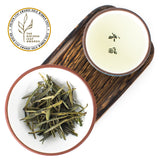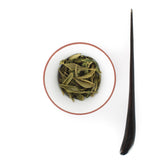A young monk asked his teacher, the wise tea master Lao Cha:
– Sifu, if Buddha were to visit you, what would you treat him to?
– How can I amaze the Enlightened One? Perhaps, but only with the Yellow Tea from Huo Mountain... The most delicious, gentle, and rare tea in the world. I’m sure that if Buddha were ever to visit me, it would be solely to get a taste of this tea.
Huo Shan Huang Ya Yellow Tea comes to life through a unique process that involves "stewing" to yellow the tea leaves. It is lightly oxidized, but the taste is more gentle than that of a green tea.
The fresh tea is hand-picked before Guyu, the 6th period of the traditional Chinese solar calendar, which usually begins around mid-April. There are different types of Huo Shan Huang Ya, each having a different picking standard, varying from a single bud to one bud and one or two leaves. After being wok-roasted, leaves are covered in bamboo trays and put into a hot receptacle for 24-48 hours of "yellowing" (Men Huang – 闷黄) – a phase unique to Yellow Tea. Under the heat, the residual moisture in the leaves starts stewing, which results in a rounded, mellow taste with chestnut notes. During the last step of making Huang Ya, the tea gets quickly exposed to a charcoal fire to dry the leaves and increase the aroma.
Huoshan is a renowned yellow tea-producing area in Anhui province. The "Huoshan County Chronicle" records mention that Huoshan Yellow Tea first appeared as early as the Western Han dynasty (202 BC – 9 AD). However, the production process back then was quite different from the Yellow Tea in the present day. Therefore, Yellow Tea from the Western Han Dynasty rather refers to a tea made from a specific tree species with yellow leaves. It wasn't until the Ming dynasty (1368–1644) that the current processing took shape. Due to its sweet, refreshing aroma and mellow taste, Huo Shan Huang Ya quickly gained popularity and was listed as a tribute tea. During the Qing Dynasty (1644–1911), it was already widespread. With the founding of the Chinese People's Republic, tea became a means of exchange and was used in trading with the Soviet Union. However, the Russians mainly drank black tea. Thus, the entire Huoshan area was transformed into a black tea production base. The art of making Yellow Tea was on the verge of extinction. It wasn't until the Sino-Soviet relationship broke down in the Battle of Zhenbao Island in 1969 that the State resumed the production of green and yellow tea in the area. At the same time, two renowned tea scholars and three tea farmers in their 80s and 90s joined forces in a desperate attempt to revive the lost art of making Yellow tea. It took two years of unceasing attempts before the Yellow Tea production process was finally restored. Today, this craft tea is still one of the most rare tea types on the market.
Huo Shan Huang Ya is a lighter oxidized yellow tea with notes resembling green tea, except rounder, sweeter, and less tannic. The strong chestnut flavor is the signature characteristic of this tea. To enjoy the fragrance and the delicious taste to the fullest, we recommend using a Gaiwan or a tall glass for brewing this tea.
In 2024, our Huo Shan Huang Ya received the Gold Medal at the prestigious Tea Competition – 'The Golden Leaf Awards', being recognized among other notable teas.
Watch a short video about Yellow Tea
- Place of Origin: Taiyang Village, Huoshan, Anhui Province, China
- Altitude: 800m
- Harvest Date: April 2025
- Picking Standard: One bud with one leaf, or one bud with two unopened leaves
- Aroma: Chestnut, slightly grassy
- Taste: Sweet and nutty; crisp and, at the same time, well-rounded.
Brewing guidelines:
 1g per 70-100ml
1g per 70-100ml ![]() 3-4min
3-4min
 1g per 25ml
1g per 25ml ![]() 5sec + 5sec for each subsequent infusion
5sec + 5sec for each subsequent infusion





